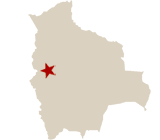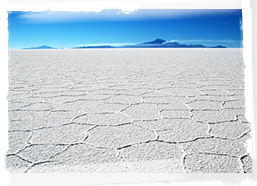An Introduction to Bolivia
Officially the Plurinational State of Bolivia, this is one of only two landlocked countries (with Paraguay) in South America. It formed part of the Inca Empire until Spanish conquest in the 16th Century, and was then known as Upper Peru. Independence in 1809 was followed by 16 years of war before the establishment of a republic - it is named after leader Sim¾n Bolívar. See full country profile.Latest Research News from Bolivia

GOVERNMENT: republic or 'Social Unitarian State'
AREA: 1,098,581 sq km
POPULATION: 10,118,683 (July 2011 est.)
MAJOR LANGUAGE: Official Language: Spanish, Quechua, Aymara and 34 other native languages

Some business and general info
The Market Research Industry
Trade and Industry in Bolivia
One such dance is the Morenada - more of a stagger than a dance as the costume looks like a stack of silver baking trays and weighs over 50kg. The slow movements represent the toil of the black slaves who worked the mines, often with little food or water, and their masks have enormous bulging eyes depicting their inability to breathe at such high altitude. The main dance, exclusive to Oruro, is the Diablada - the dance of the devil, led by Lucifer in a grotesque, papier-māchã mask with sharp silver teeth and horns. After over 20 hours of performing along the 4km route, the procession finishes inside the Socavon cathedral in the centre of town... and 72 hours of more informal partying begin.
Perhaps this leave the people with little energy left for sport. No Bolivian athlete has ever won an Olympic medal at the senior level. However, the national Under-15s football team won the country's first ever gold at the Youth Olympic Games in Singapore 2010.
Go to next country
Officially the Plurinational State of Bolivia, this is one of only two landlocked countries (with Paraguay) in South America. It formed part of the Inca Empire until Spanish conquest in the 16th Century, and was then known as Upper Peru. Independence in 1809 was followed by 16 years of war before the establishment of a republic - it is named after leader Sim¾n Bolívar.
The poorest country in South America, it has struggled through periods of political instability, dictatorship and economic woe, but now has a Medium Human Development Index score. The Bolivian population is multiethnic, including Amerindians, Mestizos, Europeans, and Africans. Spanish, Aymara and Quechua are all official languages, as are 34 other indigenous languages, and the large number of different cultures has contributed to a wide diversity in fields such as art, cuisine, literature, and music.
GDP: $47.88 billion (2010 est.) - $4,800 per capita
Religions Roman Catholic 95%, Protestant (Evangelical Methodist) 5%
Currency: Boliviano (BOB) - $1 = 10.93 BOB
Telephone Code: +591
Research Industry
In 2010 Bolivia's Market Researchers did $6m worth of business - a net growth (shrinkage) of -2.4%. This puts the industry at 67th in the world.Bolivia is one of the poorest and least developed countries in Latin America, despite being rich in natural resources including minerals such as tin. Its main economic activities include agriculture, forestry, fishing, mining, and manufacturing goods such as textiles, clothing, refined metals, and refined petroleum.
A disastrous economic crisis during the early 1980s was followed by reform and growth in the 1990s. Violent protests in 2003-05 against plans for the export of newly discovered natural gas reserves to large northern hemisphere markets brought a rethink of terms, higher royalties and requisition of foreign firms' production by the state energy company - the latter has helped the country to record trade surpluses and avoidance of much of the global recession, but unsurprisingly has also slowed foreign investment in key sectors.
In 2010 just over $6.1bn worth of products including gas, soy products, crude oil, zinc ore and tin went to countries led by Brazil and the USA, and including Peru, Colombia, Argentina and Japan. Imports valued at $4.9bn and consisting largely of petroleum products, paper, aircraft, and food, came from mainly South American sources - Brazil, Argentina, Peru and Chile - with the USA and China also involved.
Email me:
laurence@mrweb.com

